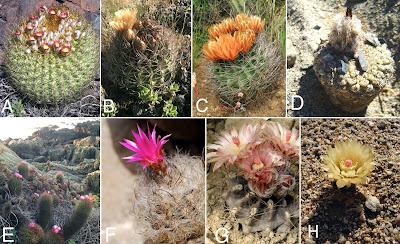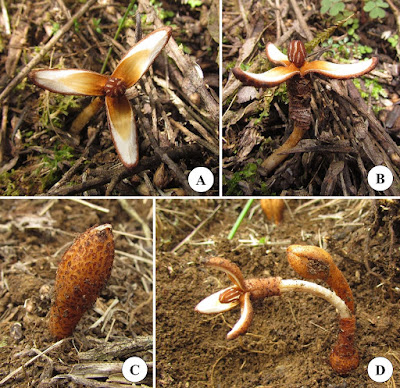 |
Phimochirus formani & P. tunnelli
Felder, Lemaitre & Craig, 2019
|
Abstract
Coloration, gene-sequence data (H3, 12s, 16s), and subtle features in morphology support the description of two new species, both formerly regarded to represent accepted variants of Phimochirus holthuisi s.l. While color in life consistently separates these species from P. holthuisi s.s. and from each other, morphological distinctions are subtle and less than absolute in small specimens, being based on ventral spine counts of walking leg dactyls and relative development of the superior crest on the major chela. Molecular phylogenetic analyses clearly support the separation of sister clades, representing two new species, from P. holthuisi s.s. as well as other congeners available for analysis. Both of the new species are presently known to occur widely throughout the northern Gulf of Mexico, though one occurs more commonly in the northeastern and southeastern Gulf, and may range as far south as Suriname. The other has been taken primarily in the northwestern Gulf, and is not known from outside Gulf waters. While both of the new species appear restricted to relatively deep subtidal waters of the continental shelf, Phimochirus holthuisi s.s. is instead more commonly found in shallow nearshore tropical waters on or near coral reefs. Previous literature reports of P. holthuisi usually represent, at least in part, one or both of these two new species.
Keywords: Crustacea, Paguroidea, Paguridae, Phimochirus, new species, Gulf of Mexico
 |
FIGURE 2. Phimochirus holthuisi (Provenzano, 1961) s.s.: A, male, sl 3.3 mm (USNM 1542650 = ULLZ 3564), Belize; B, male, sl 2.9 mm (USNM 1558313 = ULLZ 16588), Belize.
Phimochirus formani nov. sp.: C, male paratype, sl 3.1 mm (USNM 1547566 = ULLZ 14352), northeastern Gulf of Mexico; D, male paratype, sl 2.8 mm (USNM 1543170 = ULLZ 7711), northeastern Gulf of Mexico.
Phimochirus tunnelli nov. sp.: E, male paratype, sl 4.1 mm (USNM 1545269 = ULLZ 10611), northwestern Gulf of Mexico; F, ov female paratype, sl 3.9 mm (USNM 1541146 = ULLZ 5789), northwestern Gulf of Mexico. |
Family Paguridae
Phimochirus holthuisi (Provenzano, 1961) s.s.
Diagnosis. Carapace shield approximately as long as broad; rostrum broadly subtriangular, rounded. Antennular and antennal peduncles at most reaching to distal margin of corneas; antennal flagella with short setae 1 or less flagellar article in length. Right chela with dorsal surface of fixed finger with small, low nearly obsolete tubercles; palm with dorsal surface smooth, lateral and mesial margins sharply defined by weakly crenulate ridge, mesial margin expanded distally and terminating in strong, blunt spiniform angle. Carpus with dorsomesial margin weakly defined by low ridge armed with 1 proximal spine and 2 or 3 small, blunt spines distally. Dactyls of second and third pereopods approximately 1.7 times longer than propodi; dorsomesial margins each with usually 5 corneous spinules, ventromesial margins each with row of usually 5 or 6 corneous spinules. Anterior lobe of sternite between third pereopods subsemiovate, with simple setae; sternite between fourth and fifth pereopods with simple setae.
GenBank sequence accession numbers for Belize specimen (USNM 1558313 = ULLZ 16588): (H3) MK830047; (12s) MK848210; (16s) 848227.
Habitat. Occupying variety of medium sized gastropod shells, including faciolariids, turbinids, and muricids;
coral reefs, on coralline sand and rubble substrates of spur and groove reef front to backreef lagoon rubble, sands,
and seagrass beds; reef crests and shallow adjacent subtidal waters; inner continental shelf; most commonly 2–18
m, to 91 m off North Carolina, perhaps to 291 m off Georgia.
Distribution. Western Atlantic: East coast of the United States, off North Carolina and Georgia; Caribbean, including Quintana Roo (Cozumel), Belize, Virgin Islands, Jamaica, Guadeloupe, and Colombia; questionably northeastern coast of South America, Suriname to Brazil.
Phimochirus formani nov. sp.
Diagnosis. Carapace shield approximately 1.1 times longer than broad; rostrum acutely triangular, reaching
distally beyond lateral projections, terminating in strong spine. Antennular peduncles exceeding distal margins of
cornea when fully extended by approximately one-fourth length of ultimate segment. Antennal peduncles reaching
to about distal margin of corneas when fully extended, flagellum with alternating long (2 flagellar articles in length)
and short setae (less than 1 flagellar article in length). Right chela with dorsal surface of fixed finger with few wellspaced low tubercles; palm smooth dorsally or with few well-spaced low tubercles distally near base of fixed finger,
dorsomesial margin sinuous sharply defined as tuberculate or bluntly spinose ridge flaring distally and terminating
in spine-like distal angle; carpus with dorsomesial margin sharply defined by spinose ridge including strong, mesially projecting spine. Dactyls of second and third pereopods with ventromesial row of 7–9 corneous spinules (or 4
corneous spinules in very small individuals sl < 2.0 mm). Anterior lobe of sternite between third pereopods semisubovate, distal margin with simple setae; sternites between fourth and fifth pereopods with simple setae.
GenBank
sequence accession numbers for paratype (USNM 1547566 = ULLZ 14352): (H3) MK830053; (12s) MK828404;
(16s) MK848222.
Etymology. The specific name was selected to honor W. Wayne Forman, a New Orleans based environmental
scientist whose talents include an unusually broad grasp of marine biota, and who has over many years brokered
access to research sites, acquisition of research specimens, and the securing of financial support for marine scientists
working throughout the northern Gulf of Mexico.
Habitat. Occupying variety of small to medium sized gastropod shells, especially faciolariids, turbinids, and
muricids; offshore calcareous banks and deep platforms around coral reefs, especially where richly covered by
macroalgae and epifauna, including among rhodoliths; inner to middle continental shelf; 27–62 m.
Distribution. Western Atlantic: northeastern, northwestern, and southeastern Gulf of Mexico; Suriname.
Phimochirus tunnelli nov. sp.
Diagnosis. Carapace shield approximately 1.1 times longer than broad; rostrum acutely triangular, reaching
distally beyond lateral projections, terminating in strong spine. Antennular peduncles reaching to distal margins of
corneas when fully extended. Antennal peduncles reaching to approximately midlevel of corneas when fully extended; flagellum with short setae 1 to < 1 flagellar articles in length. Right chela with dorsal surface of fixed finger
covered with well-spaced low tubercles; palm with numerous well-spaced tubercles or blunt spines on distal half,
dorsomesial margin sharply defined as straight (in mesial view) crenulate or bluntly spinulose ridge terminating in
rounded or spine-like angle; carpus with dorsomesial margin sharply defined by ridge with 3 or 4 sharp proximal
spines and 2 or 3 smaller blunt distal spines. Dactyls of second and third pereopods with 3 rows of corneous spinules, one dorsomesial with 10 or 11, one ventromesial with 5–10, and one ventral with 9–11. Anterior lobe of sternite between third pereopods semisubovate, distal margin with simple and often capsulate setae; sternites between
fourth and fifth pereopods with simple setae and often short capsulate setae.
GenBank sequence accession numbers
for holotype (USNM 1547302 = ULLZ 13837): (12s) MK848209; (16s) MK848226.
Etymology. The specific name is assigned in recognition of the late John W. (Wes) Tunnell, formerly of Texas
A&M University–Corpus Christi, whose deep appreciation for, and professional understanding of, coastal and marine biodiversity in the Gulf of Mexico region is reflected in many books and other publications that he authored or
orchestrated over his long and productive career.
Habitat. Occupying varied medium sized gastropod shells, especially faciolariids, turbinids, and muricids;
offshore rhodolith and other calcareous banks, especially where richly covered by macroalgae and epifaunal communities; inner to middle continental shelf; 38–72 m.
Distribution. Western Atlantic: northeastern, northwestern, and southeastern Gulf of Mexico.
Darryl L. Felder, Rafael Lemaitre and Catherine Craig. 2019. Two New Species of the
Phimochirus holthuisi complex from the Gulf of Mexico, supported by Morphology, Color, and Genetics (Crustacea: Anomura: Paguridae).
Zootaxa. 4683(4); 531–551. DOI:
10.11646/zootaxa.4683.4.4






































